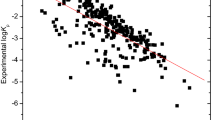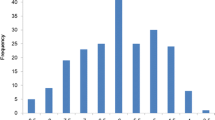Abstract
The state-of-the-art molecular solvation theory is used to predict skin permeability of a large set of compounds with available experimental skin permeability coefficient (logKP). Encouraging results are obtained pointing to applicability of a novel quantitative structure activity model that uses statistical physics based 3D-RISM-KH theory for solvation free energy calculations as a primary descriptor for the prediction of logKP with relative mean square error of 0.77 units.




Similar content being viewed by others
Notes
A summary of most prominent models developed for logKP prediction is presented in Table S1 in the ESM.
This is a modified SPC point charge model of water with additional LJ parameters for the hydrogens (σH = 1.1 Å, εH = 0.046 kcal/mol) to avoid convergence issues and getting correct thermodynamics in 1D-RISM-KH theory.
References
Hadgraft J (2004) Eur J Pharm Biopharm 58:291–299
Jepps OG, Dancik Y, Anissimov YG, Roberts MS (2013) Adv Drug Deliv Rev 65:152–168
Barbero AM, Frasch HF (2009) Toxicol In Vitro 23:1–13
Sinkó B, Garrigues TM, Balogh GT, Nagy ZK, Tsinman O, Avdeef A, Takács-Novák K (2012) Eur J Pharm Sci 45:698–707
Barratt MD (1995) Toxicol In Vitro 9:27–37
Schulz R, Yamamoto K, Klossek A, Flesch R, Hönzke S, Rancan F, Vogt A, Blume-Peytavi U, Hedtrich S, Schäfer-Korting M, Rühl E, Netz RR (2017) Proc Natl Acad Sci USA 114:3631
Schultz TW, Cronin MTD, Walker JD, Aptula AO (2003) J Mol Struct 622:1–22
Cherkasov A, Muratov EN, Fourches D, Varnek A, Baskin II, Cronin M, Dearden J, Gramatica P, Martin YC, Todeschini R, Consonni V, Kuźmin VE, Cramer R, Benigni RR, Yang C, Rathman J, Terfloth L, Gasteiger J, Richard A, Tropsha A (2014) J Med Chem 57:4977–5010
Goto S (2014) In: Ohshima H, Makino K (eds) Colloid and Interface science in pharmaceutical research and development. Elsevier, Amsterdam, pp 121–129
Mitragotri S, Anissimov YG, Bunge AL, Frasch HF, Guy RH, Hadgraft J, Kasting GB, Lane ME, Roberts MS (2011) Int J Pharma 418:115–129
Wilschut A, ten Berge WF, Robinson PJ, McKone TE (1995) Chemosphere 30:1275–1296
Zhang J, Zhang H, Wu T, Wang Q, van der Spoel D (2017) J Chem Theory Comput 13:1034–1043
Johnson J, Case DA, Yamazaki T, Gusarov S, Kovalenko A, Luchko T (2016) J Phys-Condens Matter 28:344002
Luchko T, Blinov N, Limon GC, Joyce KP, Kovalenko A (2016) J Comput-Aided Mol Des 30:1115–1127
Kovalenko A, Hirata F (2005) Phys Chem Chem Phys 7:1785–1793
Kovalenko A (2015) Cond Matt Phys 18:32601
Tsednee T, Luchko T (2019) Phys Rev B 99:032130
Palmer DS, Frolov A, Ratkova EL, Fedorov MV (2010) J Phys Codens Matter 22:492101
Shen J, Kromidas L, Schultz T, Bhatia S (2014) Food Chem Toxicol 74:164–176
Chauhan P, Shakya M (2010) SAR QSAR Environ Res 21:481–494
Moss GP, Cronin MTD (2002) Int J Pharm 238:105–109
Moss GP, Sun Y, Wilkinson SC, Davey N, Adams R, Martin GP, Prapopopolou M, Brown MB (2011) J Pharm Pharmacol 63:1411–1427
O’Boyle NM, Banck M, James CA, Morley C, Vandermeersch T, Hutchison GR (2011) J Cheminform 3:33
MOPAC2016, Stewart JJP, Stewart computational chemistry. Colorado Springs, CO, USA
Dewar MJS, Zoebisch EG, Healy EF, Stewart JJP (1985) J Am Chem Soc 107:3902–3909
Rappe AK, Casewit CJ, Colwell KS, Goddard WA, Skiff WM (1992) J Am Chem Soc 114:10024–10035
Zhao Y, Truhlar DG (2008) Theor Chem Acc 120:215–241
Ditchfield R, Hehre WJ, Pople JA (1971) J Chem Phys 54:724–728
Frisch MJ, Trucks GW, Schlegel HB, Scuseria GE, Robb MA, Cheeseman JR, Scalmani G, Barone V, Petersson GA, Nakatsuji H, Li X, Caricato M, Marenich AV, Bloino J, Janesko BG, Gomperts R, Mennucci B, Hratchian HP, Ortiz JV, Izmaylov AF, Sonnenberg JL, Williams-Young D, Ding F, Lipparini F, Egidi F, Goings J, Peng B, Petrone A, Henderson T, Ranasinghe D, Zakrzewski VG, Gao J, Rega N, Zheng G, Liang W, Hada M, Ehara M, Toyota K, Fukuda R, Hasegawa J, Ishida M, Nakajima T, Honda Y, Kitao O, Nakai H, Vreven T, Throssell K, Montgomery JA Jr, Peralta JE, Ogliaro F, Bearpark MJ, Heyd JJ, Brothers EN, Kudin KN, Staroverov VN, Keith TA, Kobayashi R, Normand J, Raghavachari K, Rendell AP, Burant JC, Iyengar SS, Tomasi J, Cossi M, Millam JM, Klene M, Adamo C, Cammi R, Ochterski JW, Martin RL, Morokuma K, Farkas O, Foresman JB, Fox DJ (2016) Gaussian 16, revision B.01. Gaussian Inc., Wallingford CT
Perkyns J, Pettitt BM (1992) J Chem Phys 97:7656–7666
Roy D, Blinov N, Kovalenko A (2017) J Phys Chem B 121:9268–9273
Molecular Operating Environment (MOE), 2013.08; Chemical Computing Group ULC, 1010 Sherbooke St. West, Suite #910, Montreal, QC, Canada, H3A 2R7, 2018
Yap CW (2011) J Comput Chem 32:1466–1474
Matos GDR, Kyu DY, Loeffler HH, Chodera JD, Shirts MR, Mobley DL (2017) J Chem Eng Data 62:1559–1569
Head-Gordon M, Pople JA, Frisch MJ (1998) Chem Phys Lett 153:503–506
Weigned F (2006) Phys Chem Chem Phys 8:1057–1065
Ertl P, Rohde B, Selzer P (2000) J Med Chem 43:3714–3717
Wang R, Fu Y, Lai L (1997) J Chem Inf Comput Sci 37:615–621
Wildman SA, Crippen GM (1999) J Chem Inf Comput Sci 39:868–873
Viswanadhan VN, Ghose AK, Revankar GR, Robins RK (1989) J Chem Inf Comput Sci 29:163–172
Acknowledgements
This work was financially supported by the NSERC Discovery Grant (RES0029477), and Alberta Prion Research Institute Explorations VII Research Grant (RES0039402). Generous computing time provided by WestGrid (www.westgrid.ca) and Compute Canada/Calcul Canada (www.computecanada.ca) is acknowledged.
Author information
Authors and Affiliations
Corresponding author
Ethics declarations
Conflict of interest
The authors declare that they have no conflict of interest.
Additional information
Publisher's Note
Springer Nature remains neutral with regard to jurisdictional claims in published maps and institutional affiliations.
Electronic supplementary material
Below is the link to the electronic supplementary material.
Rights and permissions
About this article
Cite this article
Hinge, V.K., Roy, D. & Kovalenko, A. Predicting skin permeability using the 3D-RISM-KH theory based solvation energy descriptors for a diverse class of compounds. J Comput Aided Mol Des 33, 605–611 (2019). https://doi.org/10.1007/s10822-019-00205-z
Received:
Accepted:
Published:
Issue Date:
DOI: https://doi.org/10.1007/s10822-019-00205-z




